FIAT PALIO 2003 178 / 1.G India Version Workshop Manual
Manufacturer: FIAT, Model Year: 2003, Model line: PALIO, Model: FIAT PALIO 2003 178 / 1.GPages: 156, PDF Size: 6.27 MB
Page 51 of 156
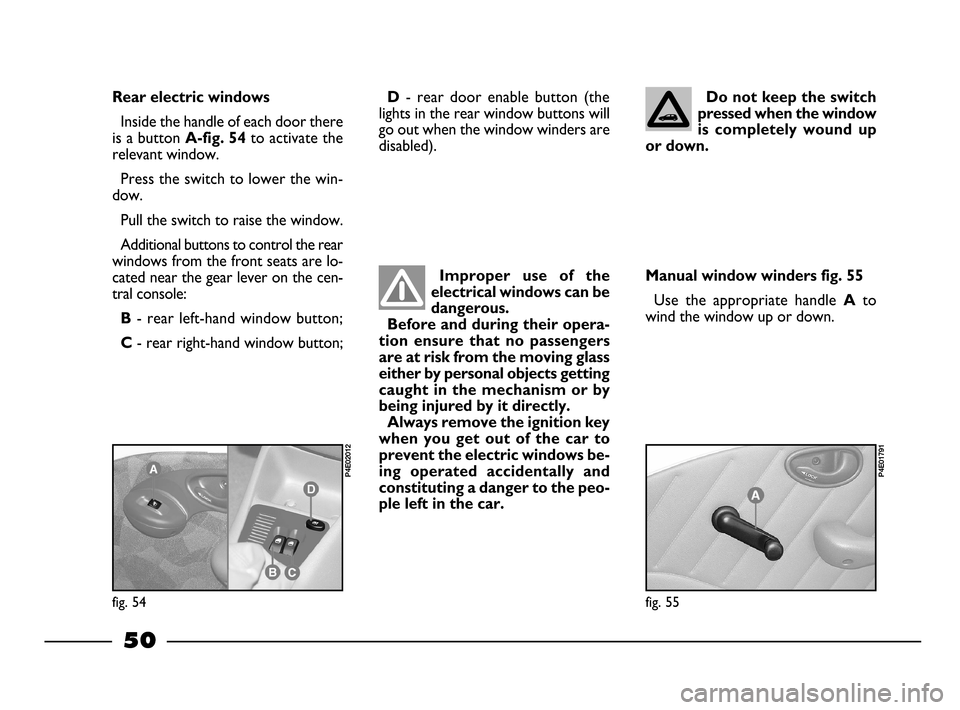
50
Do not keep the switch
pressed when the window
is completely wound up
or down.
Improper use of the
electrical windows can be
dangerous.
Before and during their opera-
tion ensure that no passengers
are at risk from the moving glass
either by personal objects getting
caught in the mechanism or by
being injured by it directly.
Always remove the ignition key
when you get out of the car to
prevent the electric windows be-
ing operated accidentally and
constituting a danger to the peo-
ple left in the car.
fig. 54
P4E02012
Rear electric windows
Inside the handle of each door there
is a button
A-fig. 54to activate the
relevant window.
Press the switch to lower the win-
dow.
Pull the switch to raise the window.
Additional buttons to control the rear
windows from the front seats are lo-
cated near the gear lever on the cen-
tral console:
B - rear left-hand window button;
C - rear right-hand window button;
D - rear door enable button (the
lights in the rear window buttons will
go out when the window winders are
disabled).
Manual window winders fig. 55
Use the appropriate handleA to
wind the window up or down.
fig. 55
P4E01791
20-63 03/03/2003 06:03 PM Page 50
Page 52 of 156
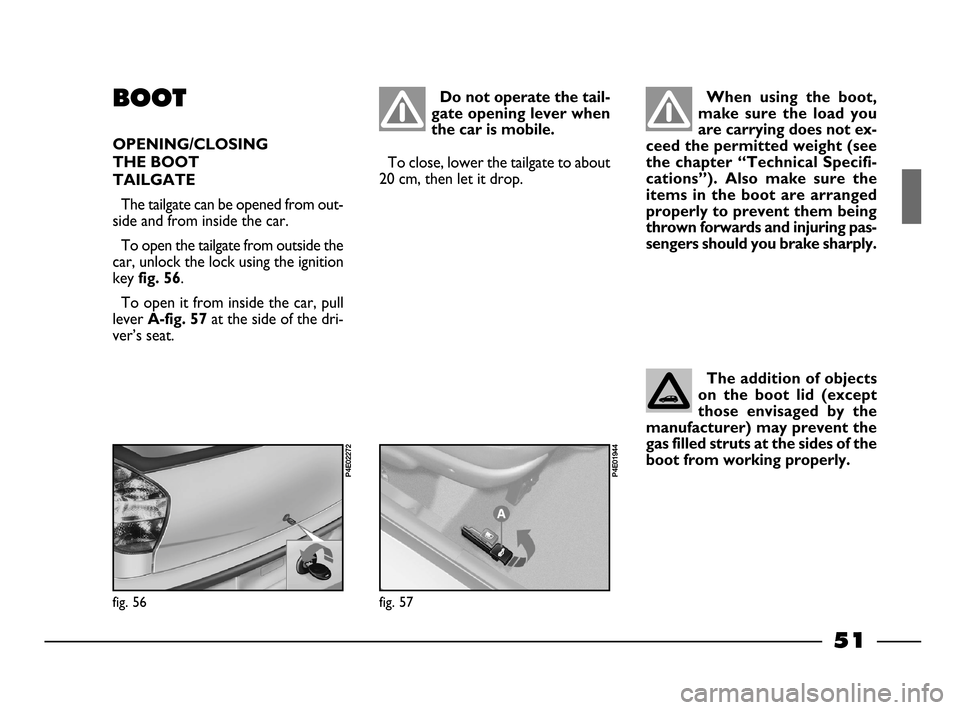
51
When using the boot,
make sure the load you
are carrying does not ex-
ceed the permitted weight (see
the chapter “Technical Specifi-
cations”). Also make sure the
items in the boot are arranged
properly to prevent them being
thrown forwards and injuring pas-
sengers should you brake sharply.BOOT
OPENING/CLOSING
THE BOOT
TAILGATE
The tailgate can be opened from out-
side and from inside the car.
To open the tailgate from outside the
car, unlock the lock using the ignition
key
fig. 56.
To open it from inside the car, pull
lever
A-fig. 57at the side of the dri-
ver’s seat.
Do not operate the tail-
gate opening lever when
the car is mobile.
To close, lower the tailgate to about
20 cm, then let it drop.
fig. 56
P4E02272
fig. 57
P4E01944
The addition of objects
on the boot lid (except
those envisaged by the
manufacturer) may prevent the
gas filled struts at the sides of the
boot from working properly.
20-63 03/03/2003 06:03 PM Page 51
Page 53 of 156
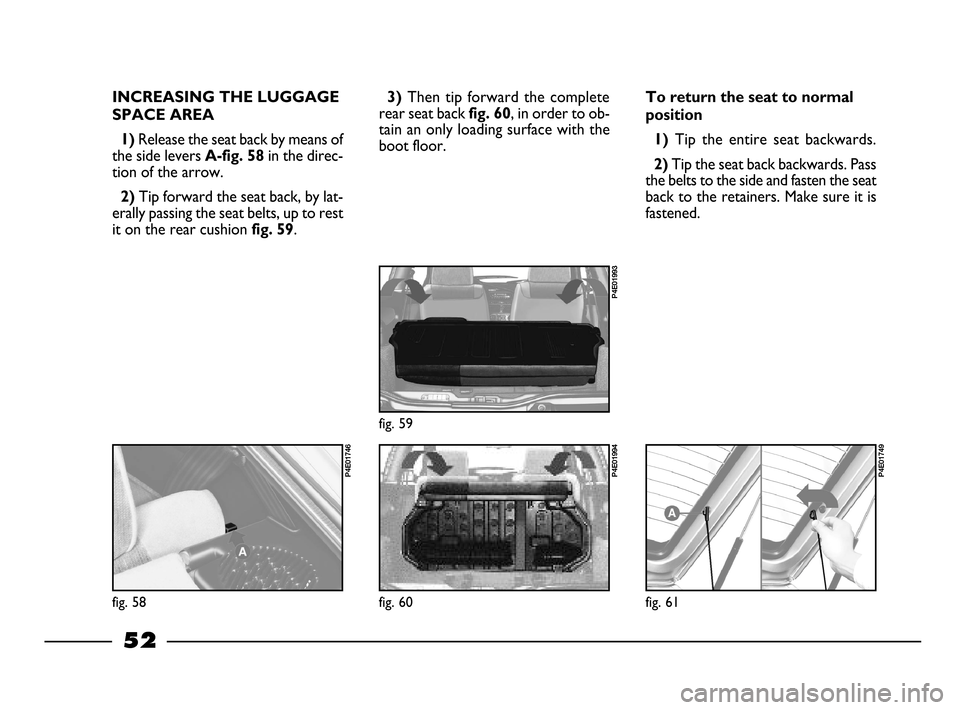
52
To return the seat to normal
position
1)
Tip the entire seat backwards.
2) Tip the seat back backwards. Pass
the belts to the side and fasten the seat
back to the retainers. Make sure it is
fastened.
INCREASING THE LUGGAGE
SPACE AREA
1)
Release the seat back by means of
the side levers
A-fig. 58in the direc-
tion of the arrow.
2) Tip forward the seat back, by lat-
erally passing the seat belts, up to rest
it on the rear cushion
fig. 59.
3) Then tip forward the complete
rear seat back
fig. 60, in order to ob-
tain an only loading surface with the
boot floor.
fig. 58
P4E01746
fig. 59
P4E01993
fig. 60
P4E01994
fig. 61
P4E01749
20-63 03/03/2003 06:03 PM Page 52
Page 54 of 156
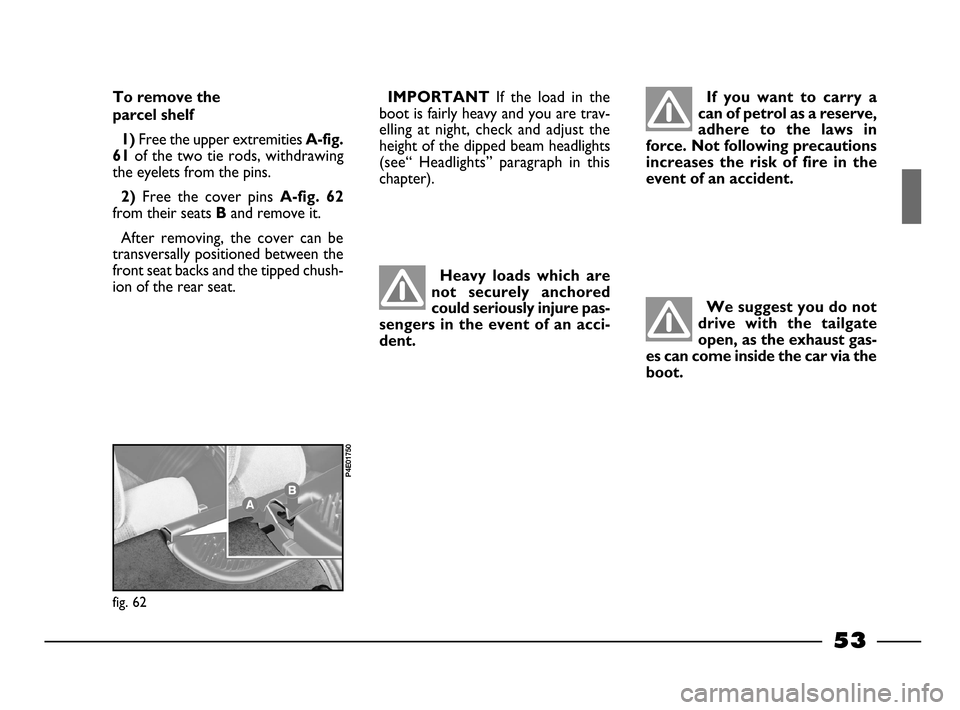
53
If you want to carry a
can of petrol as a reserve,
adhere to the laws in
force. Not following precautions
increases the risk of fire in the
event of an accident. To remove the
parcel shelf
1)
Free the upper extremities A-fig.
61
of the two tie rods, withdrawing
the eyelets from the pins.
2)Free the cover pins A-fig. 62
from their seats Band remove it.
After removing, the cover can be
transversally positioned between the
front seat backs and the tipped chush-
ion of the rear seat.
IMPORTANT If the load in the
boot is fairly heavy and you are trav-
elling at night, check and adjust the
height of the dipped beam headlights
(see“ Headlights” paragraph in this
chapter).
Heavy loads which are
not securely anchored
could seriously injure pas-
sengers in the event of an acci-
dent.
We suggest you do not
drive with the tailgate
open, as the exhaust gas-
es can come inside the car via the
boot.
fig. 62
P4E01750
20-63 03/03/2003 06:03 PM Page 53
Page 55 of 156
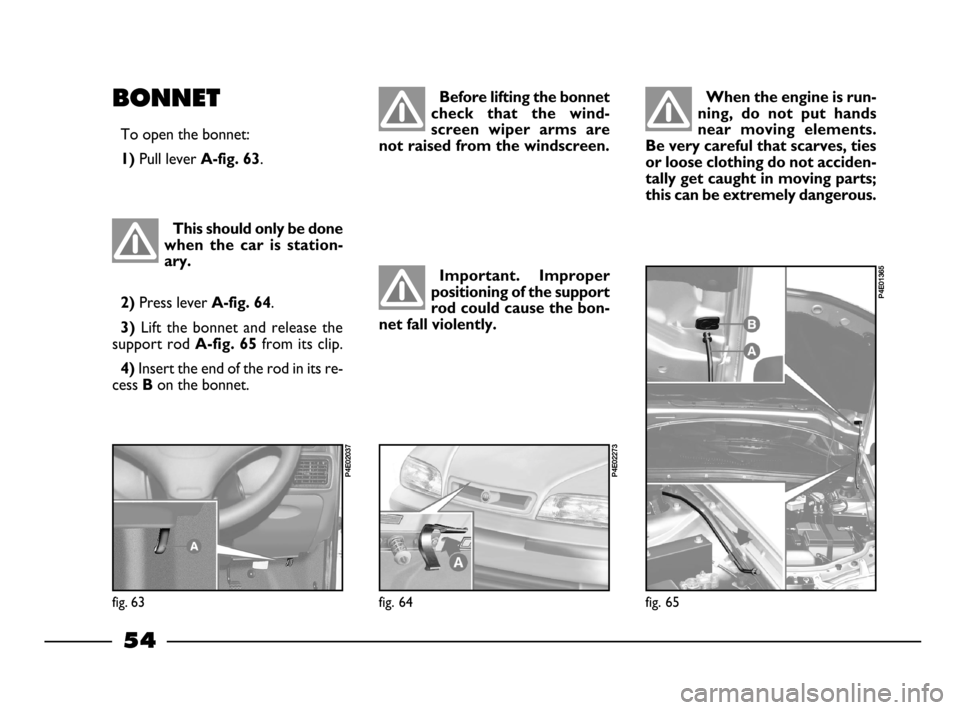
54
When the engine is run-
ning, do not put hands
near moving elements.
Be very careful that scarves, ties
or loose clothing do not acciden-
tally get caught in moving parts;
this can be extremely dangerous.BONNET
To open the bonnet:
1) Pull lever A-fig. 63.
fig. 64
P4E02273
fig. 65
P4E01365
Before lifting the bonnet
check that the wind-
screen wiper arms are
not raised from the windscreen.
Important. Improper
positioning of the support
rod could cause the bon-
net fall violently.
This should only be done
when the car is station-
ary.
2)Press lever A-fig. 64.
3)Lift the bonnet and release the
support rod
A-fig. 65from its clip.
4)Insert the end of the rod in its re-
cess
Bon the bonnet.
fig. 63
P4E02037
20-63 03/03/2003 06:03 PM Page 54
Page 56 of 156
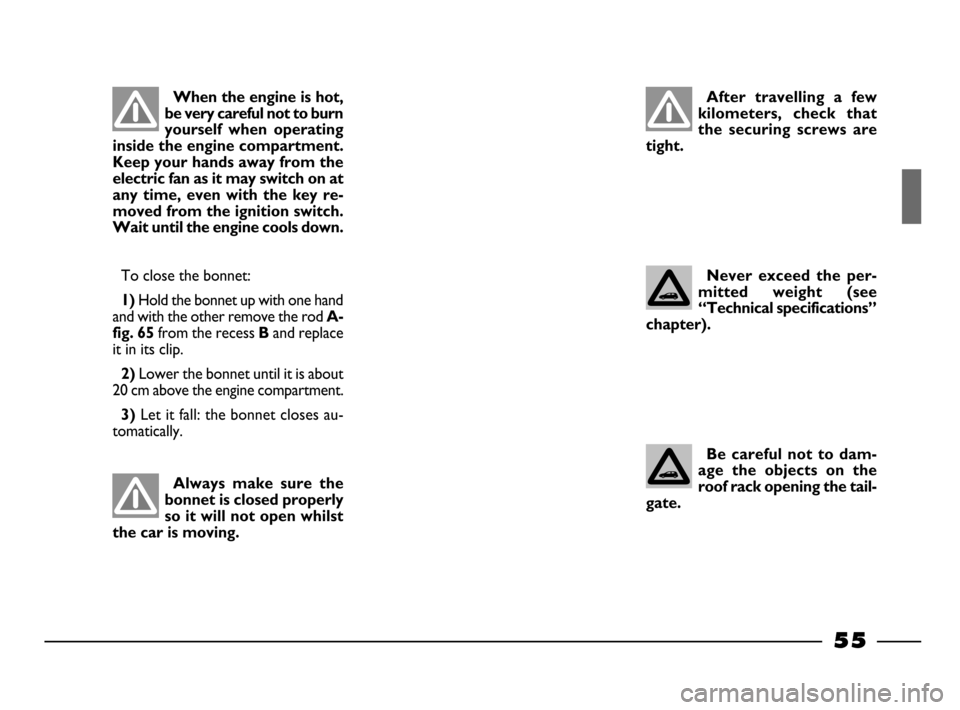
55
To close the bonnet:
1) Hold the bonnet up with one hand
and with the other remove the rod
A-
fig. 65
from the recess Band replace
it in its clip.
2)Lower the bonnet until it is about
20 cm above the engine compartment.
3) Let it fall: the bonnet closes au-
tomatically.
ROOF RACK
Move the door weather strips aside
in the points shown in
fig. 66to reach
the fasteners.
When the engine is hot,
be very careful not to burn
yourself when operating
inside the engine compartment.
Keep your hands away from the
electric fan as it may switch on at
any time, even with the key re-
moved from the ignition switch.
Wait until the engine cools down.
Always make sure the
bonnet is closed properly
so it will not open whilst
the car is moving.
After travelling a few
kilometers, check that
the securing screws are
tight.
Never exceed the per-
mitted weight (see
“Technical specifications”
chapter).
Be careful not to dam-
age the objects on the
roof rack opening the tail-
gate.
20-63 03/03/2003 06:03 PM Page 55
Page 57 of 156
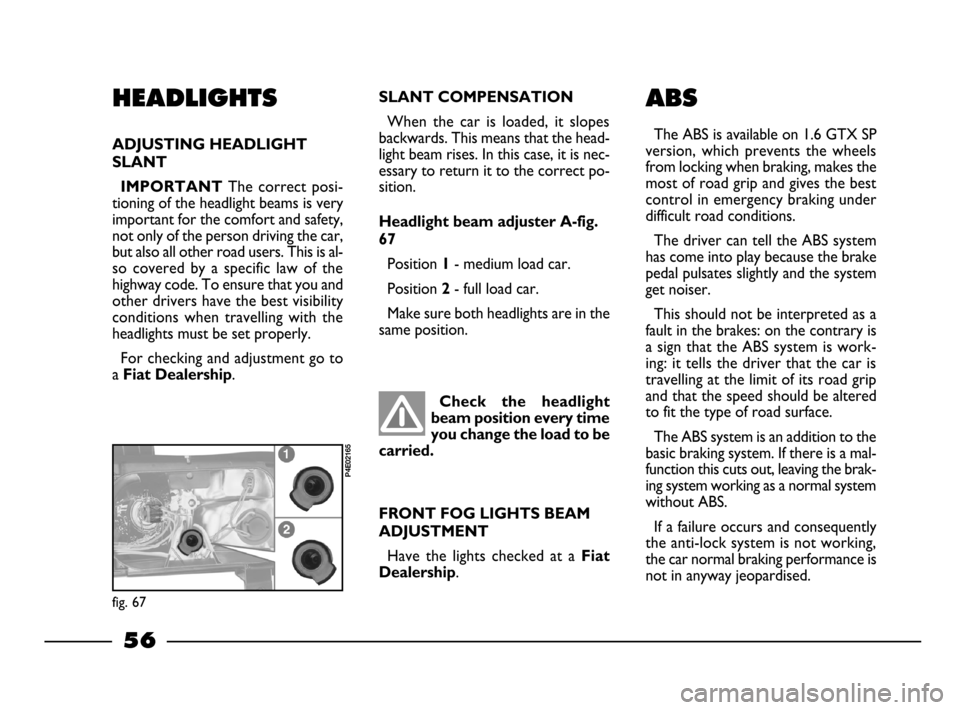
56
SLANT COMPENSATION
When the car is loaded, it slopes
backwards. This means that the head-
light beam rises. In this case, it is nec-
essary to return it to the correct po-
sition.
Headlight beam adjuster A-fig.
67
Position 1- medium load car.
Position
2- full load car.
Make sure both headlights are in the
same position.
Check the headlight
beam position every time
you change the load to be
carried.
FRONT FOG LIGHTS BEAM
ADJUSTMENT
Have the lights checked at a Fiat
Dealership
.
ABS
The ABS is available on 1.6 GTX SP
version, which prevents the wheels
from locking when braking, makes the
most of road grip and gives the best
control in emergency braking under
difficult road conditions.
The driver can tell the ABS system
has come into play because the brake
pedal pulsates slightly and the system
get noiser.
This should not be interpreted as a
fault in the brakes: on the contrary is
a sign that the ABS system is work-
ing: it tells the driver that the car is
travelling at the limit of its road grip
and that the speed should be altered
to fit the type of road surface.
The ABS system is an addition to the
basic braking system. If there is a mal-
function this cuts out, leaving the brak-
ing system working as a normal system
without ABS.
If a failure occurs and consequently
the anti-lock system is not working,
the car normal braking performance is
not in anyway jeopardised.
HEADLIGHTS
ADJUSTING HEADLIGHT
SLANT
IMPORTANT
The correct posi-
tioning of the headlight beams is very
important for the comfort and safety,
not only of the person driving the car,
but also all other road users. This is al-
so covered by a specific law of the
highway code. To ensure that you and
other drivers have the best visibility
conditions when travelling with the
headlights must be set properly.
For checking and adjustment go to
a
Fiat Dealership.
fig. 67
P4E02165
20-63 03/03/2003 06:03 PM Page 56
Page 58 of 156
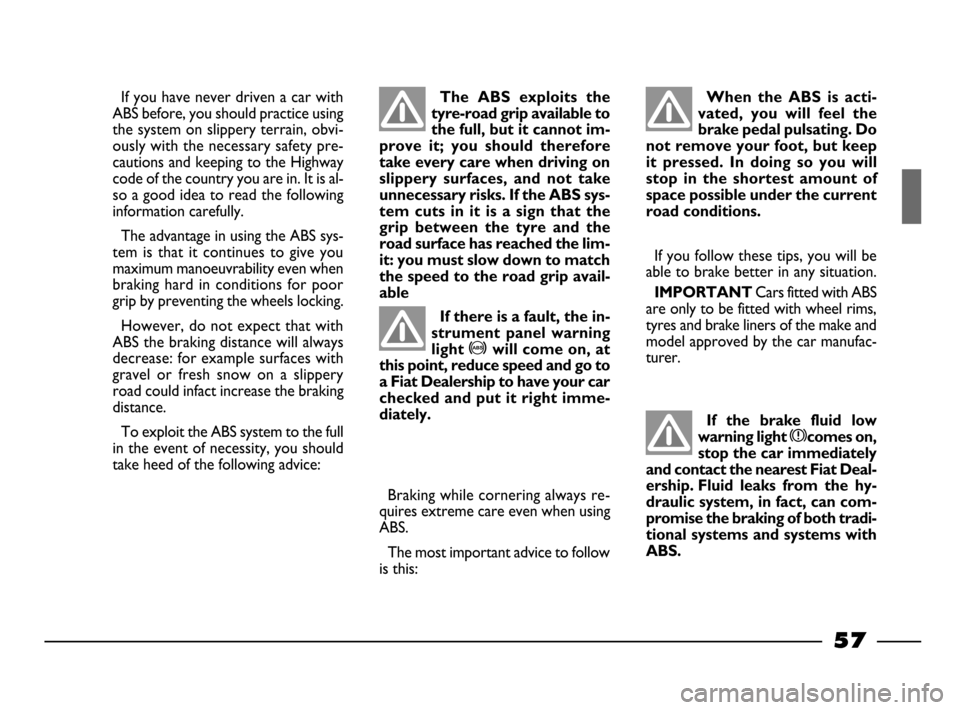
57
If you have never driven a car with
ABS before, you should practice using
the system on slippery terrain, obvi-
ously with the necessary safety pre-
cautions and keeping to the Highway
code of the country you are in. It is al-
so a good idea to read the following
information carefully.
The advantage in using the ABS sys-
tem is that it continues to give you
maximum manoeuvrability even when
braking hard in conditions for poor
grip by preventing the wheels locking.
However, do not expect that with
ABS the braking distance will always
decrease: for example surfaces with
gravel or fresh snow on a slippery
road could infact increase the braking
distance.
To exploit the ABS system to the full
in the event of necessity, you should
take heed of the following advice:
If the brake fluid low
warning light x
comes on,
stop the car immediately
and contact the nearest Fiat Deal-
ership. Fluid leaks from the hy-
draulic system, in fact, can com-
promise the braking of both tradi-
tional systems and systems with
ABS.When the ABS is acti-
vated, you will feel the
brake pedal pulsating. Do
not remove your foot, but keep
it pressed. In doing so you will
stop in the shortest amount of
space possible under the current
road conditions.
If you follow these tips, you will be
able to brake better in any situation.
IMPORTANTCars fitted with ABS
are only to be fitted with wheel rims,
tyres and brake liners of the make and
model approved by the car manufac-
turer.
The ABS exploits the
tyre-road grip available to
the full, but it cannot im-
prove it; you should therefore
take every care when driving on
slippery surfaces, and not take
unnecessary risks. If the ABS sys-
tem cuts in it is a sign that the
grip between the tyre and the
road surface has reached the lim-
it: you must slow down to match
the speed to the road grip avail-
able
If there is a fault, the in-
strument panel warning
light
>will come on, at
this point, reduce speed and go to
a Fiat Dealership to have your car
checked and put it right imme-
diately.
Braking while cornering always re-
quires extreme care even when using
ABS.
The most important advice to follow
is this:
20-63 03/03/2003 06:03 PM Page 57
Page 59 of 156
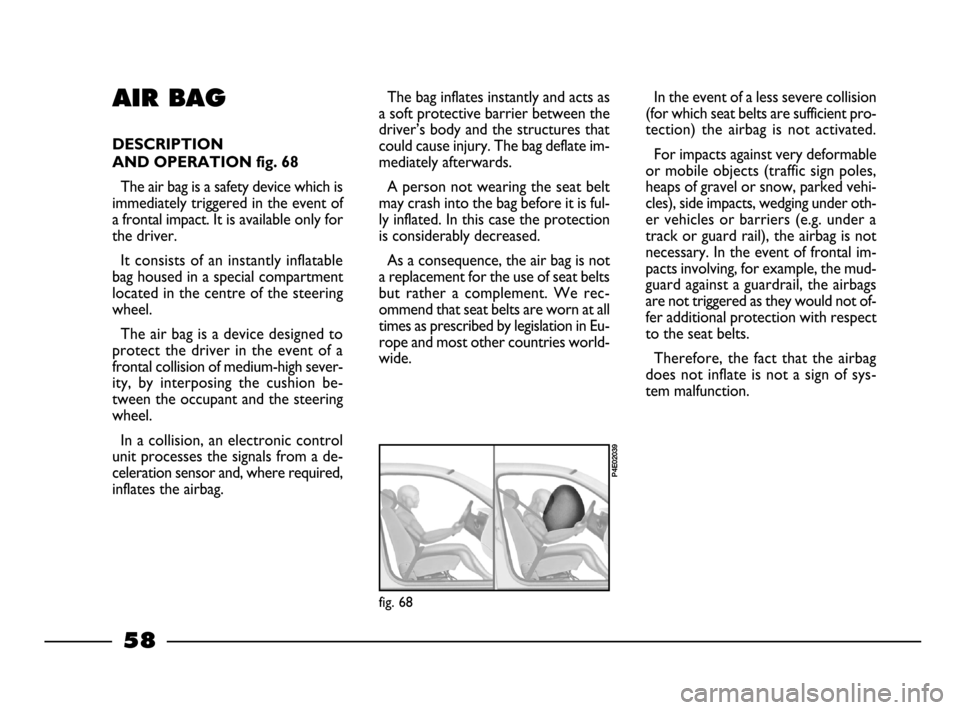
58
The bag inflates instantly and acts as
a soft protective barrier between the
driver’s body and the structures that
could cause injury. The bag deflate im-
mediately afterwards.
A person not wearing the seat belt
may crash into the bag before it is ful-
ly inflated. In this case the protection
is considerably decreased.
As a consequence, the air bag is not
a replacement for the use of seat belts
but rather a complement. We rec-
ommend that seat belts are worn at all
times as prescribed by legislation in Eu-
rope and most other countries world-
wide.In the event of a less severe collision
(for which seat belts are sufficient pro-
tection) the airbag is not activated.
For impacts against very deformable
or mobile objects (traffic sign poles,
heaps of gravel or snow, parked vehi-
cles), side impacts, wedging under oth-
er vehicles or barriers (e.g. under a
track or guard rail), the airbag is not
necessary. In the event of frontal im-
pacts involving, for example, the mud-
guard against a guardrail, the airbags
are not triggered as they would not of-
fer additional protection with respect
to the seat belts.
Therefore, the fact that the airbag
does not inflate is not a sign of sys-
tem malfunction.AIR BAG
DESCRIPTION
AND OPERATION fig. 68
The air bag is a safety device which is
immediately triggered in the event of
a frontal impact. It is available only for
the driver.
It consists of an instantly inflatable
bag housed in a special compartment
located in the centre of the steering
wheel.
The air bag is a device designed to
protect the driver in the event of a
frontal collision of medium-high sever-
ity, by interposing the cushion be-
tween the occupant and the steering
wheel.
In a collision, an electronic control
unit processes the signals from a de-
celeration sensor and, where required,
inflates the airbag.
fig. 68
P4E02039
20-63 03/03/2003 06:03 PM Page 58
Page 60 of 156

59
When the ignition key is
turned to MAR, the indi-
cator û
comes on after
about four seconds. If the warn-
ing light does not come on, or it
remains on while travelling go
immediately to a Fiat Dealership.
Do not apply stickers or
other objects on the
steering wheel. Do not
travel with items on your lap, in
front of you or with a pipe, pencil
etc. between your lips. In a colli-
sion where the airbag is triggerd
you could seriously hurt yourself
GENERAL WARNINGS
It may happen that the air bag
inflates if the car is involved in
hard impacts or collisions in the
area of the underbody, for exam-
ple hard knocks against steps,
kerbs or raised road bumps, or if
the car drops into large pot-holes
or road dips.
When the airbag inflates it
emits a small amount of dust and
smoke. This dust and smoke is
harmless and it is not the begin-
ning of a fire.
If the warning light
ûcomes on
while travelling (indication of a
fault) go as soon as possible to a
Fiat Dealership.
The air bag system is valid for 10
years. When the expiry date is
near, contact a Fiat Dealership.
Should an accident occur in
which the airbag is activated,
take the car to a Fiat Dealership
to have the whole device re-
placed (electronic control unit,
seat belts, pretensioners) and tohave the electrical system
checked.
Any diagnostic, repair or re-
placement operations concerning
the airbag system must exclu-
sively be carried out at a Fiat
Dealership.
If you are having the car
scrapped, have the airbag system
deactivated at a Fiat Dealership.
If the car changes hands, the
new owner must be made aware
of the indications given above and
be given this Owner’s Handbook.
Pretensioners (if electronically
controlled) and air bag are trig-
gered by the electronic control
unit according to different types
of impact. Therefore, if some de-
vices do not trigger this does not
indicate a fault in the system.
20-63 03/03/2003 06:03 PM Page 59